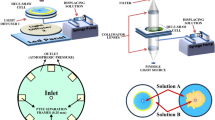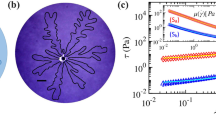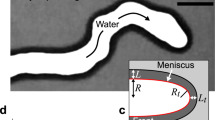Abstract
The problem of interface pattern selection in nonlinear dissipative systems is critical in many fields of science, occurring in physical, chemical and biological systems. One of the simplest pattern formations is the Saffman–Taylor finger pattern1 that forms when a viscous fluid is displaced by a less viscous fluid. Such finger-shaped patterns have been observed in distinctly different fields of science2,3,4 (hydrodynamics, combustion and crystal growth) and this has led to a search for a unified concept of pattern formation, as first proposed by the classic work of D'arcy Thomson5. Two-dimensional finger-shaped patterns, observed in flame fronts6 and the ensembled average shape of the diffusion-limited aggregation pattern, have been shown to be similar to Saffman–Taylor finger shapes7,8. Here we present experimental studies that establish that the cell shapes formed during directional solidification of alloys can be described by the form of the Saffman–Taylor finger shape equation when a second phase is present in the intercellular region.
This is a preview of subscription content, access via your institution
Access options
Subscribe to this journal
Receive 12 print issues and online access
$259.00 per year
only $21.58 per issue
Buy this article
- Purchase on Springer Link
- Instant access to full article PDF
Prices may be subject to local taxes which are calculated during checkout


Similar content being viewed by others
References
Saffman, P.G. & Taylor, G.I. The penetration of a fluid into a porous medium or Hele-Shaw cell containing a more viscous liquid. Proc. R. Soc. Lond. A 245, 312–329 (1958).
Pelce, P. Dynamics of Curved Fronts (Academic, Oxford, 1988)
Kessler, D., Koplik, J. & Levine, H. Pattern selection in fingered growth phenomena. Adv. Phys. 37(3), 255–339 (1988).
Langer, J.S. in Chance and Matter (ed. Souleite, J.) (North Holland, Amsterdam, 1987).
Thomson, D.W. On Growth and Form (Cambridge Univ. Press, 1942).
Britten, J.A., Krantz W.B., Visser, W. & Gunn, R.D. Theoretical and Experimental Studies of Reverse Combustion (Internal report, Univ.of Colorado, Boulder, 1985).
Couder, Y, Argoul, F, Arnéodi, A., Maurer, J. & Ribaud, M. Statistical properties of the fractal dendrites and anisotropic diffusion-limited aggregates. Phys. Rev. A 42, 3499–3503 (1990).
Arneodo, A., Argoul, F., Couder, Y. & Ribaud, M. Anisotropic Laplacian growths: from diffusion-limited aggregates to dendrite fractals. Phys. Rev. Lett. 66, 2332–2335 (1991).
Somboonsuk, K., Mason, J.T. & Trivedi, R. Interdendritic spacing: Part 1. Experimental studies. Metall. Trans. 15A, 967–975 (1984).
Pelcé, P. & Pumir, A. Cell shape in directional solidification in the small Peclet number limit. J. Cryst. Growth 73, 337–341 (1985).
Billia, B., Jamgotchian, H. & Capella, L. Pattern formation during directional solidification. J. Cryst. Growth, 82, 747–756 (1987).
Billia, B. & Trivedi, R. Pattern formation in crystal growth. In Handbook of Crystal Growth (2b), 993 (North Holland, Amsterdam, 1995).
Weeks, J.D., Van Sarloos, W. & Grant, M. Stability and shapes of cellular profiles in directional solidification: expansion and matching methods. J. Cryst. Growth 112, 244–282 (1991).
Karma, A. & Pelce, P. Stability of an array of deep cells in directional solidification. Phys Rev A, 41, 6741–6748 (1990).
Dombre, T. & Hakim, V. Saffman–Taylor fingers and directional solidification at low velocity. Phys. Rev. A 36(6), 2811–2817 (1987).
Trivedi, R., Shen, Y. & Liu, S. A unique correlation among cellular microstructural length scales in directionally solidified binary systems. In Proc. Int. Conf. Advances in Materials and Materials Processing (ed. Chakraborty, N. & Chatterjee, U.) 42–49 (Tata McGraw-Hill, 2001).
Levine, H. & Tu, Y. Mean-field diffusion-limited aggregation and the Saffman–Taylor problem in three dimensions. Phys. Rev. A 45(2), 1044–1052 (1992).
Brener, E. Non-axisymmetric patterns in the Saffman–Taylor problem and in the three dimension directional solidification at low velocity. Phys. Rev. E 48, 4437–4443 (1993).
Scheil, E. Bemerkungen zur Schichtkristasllbildung. Z. Metallkunde 34, 70–72 (1942).
Acknowledgements
This work was supported by the Office of Microgravity, NASA, and funded through the Marshall Space Flight Center.
Author information
Authors and Affiliations
Corresponding author
Ethics declarations
Competing interests
The authors declare no competing financial interests.
Rights and permissions
About this article
Cite this article
Trivedi, R., Liu, S. & Williams, S. Interface pattern formation in nonlinear dissipative systems. Nature Mater 1, 157–159 (2002). https://doi.org/10.1038/nmat749
Received:
Accepted:
Published:
Issue Date:
DOI: https://doi.org/10.1038/nmat749
This article is cited by
-
Helical crack-front instability in mixed-mode fracture
Nature (2010)
-
The Growth of a Single Cell/Dendrite in a Directional Solidification Process
Metallurgical and Materials Transactions A (2007)
-
Orientation selection in dendritic evolution
Nature Materials (2006)
-
In situ characterization of interface-microstructure dynamics in 3D-Directional Solidification of model transparent alloys
Microgravity - Science and Technology (2005)



